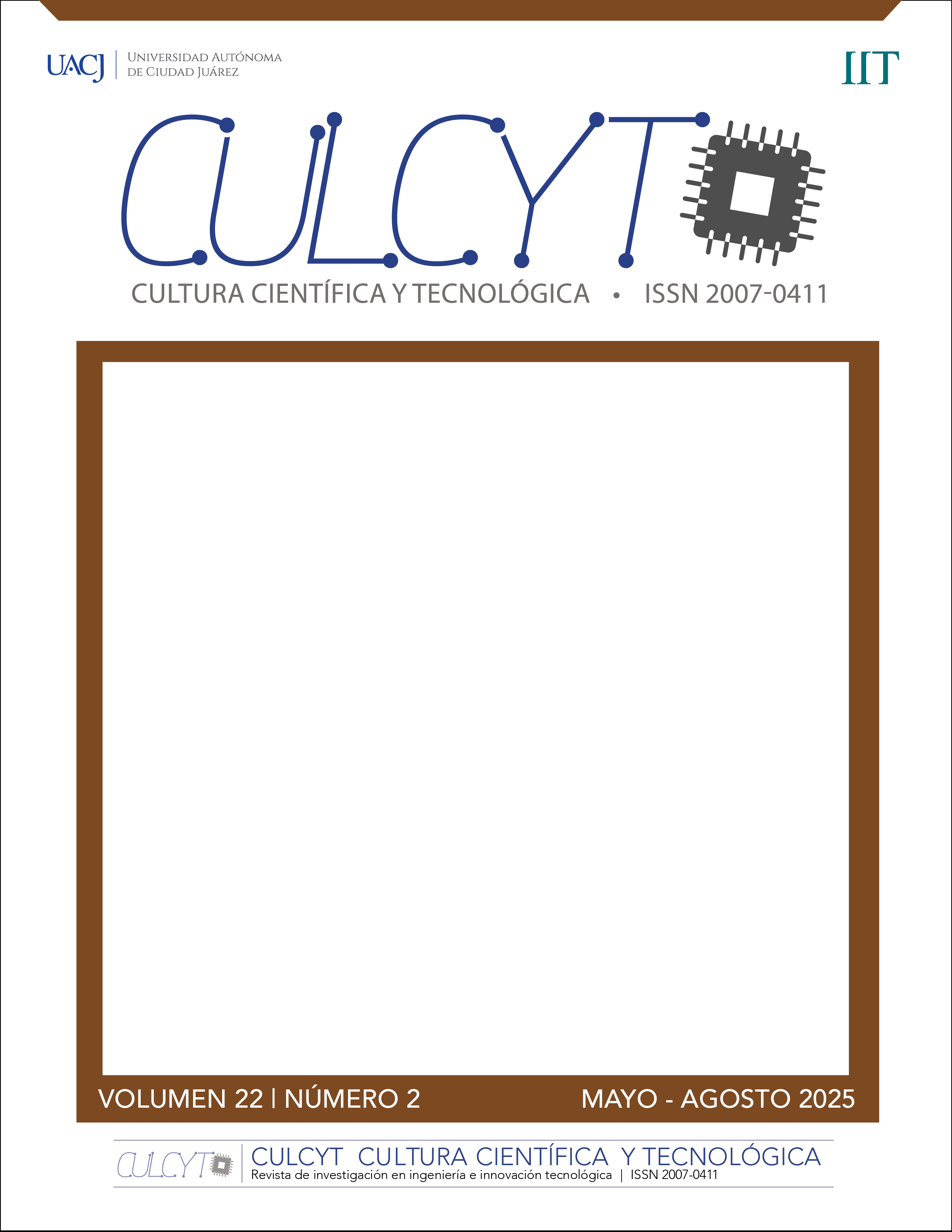Sistema IoT de monitoreo y control inteligente para cama de cría de lombriz californiana
DOI:
https://doi.org/10.20983/culcyt.2025.2.4e.1Palabras clave:
sistema IoT, monitoreo y control, vermicomposta, lombriz californianaResumen
El objetivo de esta investigación es desarrollar un sistema basado en Internet de las Cosas (IoT) para el monitoreo y control en tiempo real de variables climatológicas clave, como la temperatura y la humedad, en una cama de lombriz californiana (Eisenia fetida). Este sistema está diseñado para mantener la salud de la colonia de lombrices, mejorando las condiciones de cría y maximizando la producción de humus sólido y lixiviado. Se pretende que el sistema IoT propuesto permita un control remoto eficiente, monitoreando las condiciones de la cama de cría y ajustando las variables para prevenir escenarios desfavorables para la salud de las lombrices. Con la incorporación de sensores IoT y un diseño estructural, que incluye mecanismos de aireación y recolección de lixiviados, se busca garantizar un monitoreo y control óptimos para asegurar la producción continua de vermicomposta de alta calidad. Como resultados preliminares, se ha logrado la construcción de la caja de cría, la selección adecuada de los sensores y la validación del sistema mediante pruebas de medición de temperatura y humedad. Actualmente, el siguiente paso consiste en integrar todos los componentes y realizar ensayos con las lombrices, con el fin de evaluar el desempeño del sistema en condiciones reales de operación.
Descargas
Citas
R. Manchal, T. Venuste y S. R. Verma, “Vermicomposting, a key to sustainable agriculture: A review”, Farm. Manage., vol. 8, n.º 2, pp. 81-93, dic. 2023, doi: 10.31830/2456-8724.2023.fm-128.
K. Yadav, N. Singh, S. Nayak y S. Kumar, “Sustainable vermicomposting: an eco-friendly approach to boost crop productivity”, en Futuristic Trends in Agriculture Engineering & Food Sciences, IIIP Series, 2024, cap. 4. doi: 10.58532/v3bcag16p2ch1.
V. B. Shalini, A. U. Maheswari, C. Marimuthu y J. Jeshima, “Vermi-Composting using AI in IoT”, 2022 International Conference on Applied Artificial Intelligence and Computing (ICAAIC), Salem, India, 2022, pp. 1489-1493, doi: 10.1109/ICAAIC53929.2022.9793207.
P. Román, M. M. Martínez y A. Pantoja, Manual de compostaje del agricultor. Experiencias en América Latina. Chile: FAO, 2013.
V. G. Sonole, Soumya CB, A. Meghana y M. G. Shetty, “Vermicompost: An integral part in urban agriculture”, Int. J. Res. Agron., vol. 7, n.º 8, parte B, pp. 89-92, 2024, doi: 10.33545/2618060x.2024.v7.i8b.1191.
FAO, Rikolto y RUAF, Urban and peri-urban agriculture sourcebook. From production to food systems. Roma: FAO and Rikolto, 2022. [En línea]. Disponible: https://doi.org/10.4060/cb9722en
“Growing greener cities in Africa”, Food and Agriculture Organization, Roma, Italia, First status report on urban and peri-urban horticulture in Africa, 2012. Accedido: en. 11, 2024. [En línea]. Disponible: https://www.fao.org/4/i3002e/i3002e.pdf
“¿Qué es un huerto urbano?”. Iberdrola.com. Accedido: oct. 20, 2024. [En línea]. Disponible: https://www.iberdrola.com/compromiso-social/que-es-un-huerto-urbano
I. I. Bashour y A. H. Sayegh, Methods of Analysis for Soils of Arid and Semi-arid Regions. Roma: Food and Agriculture Organization of the United Nations, 2007.
FAO, El estado de los recursos de tierras y aguas del mundo para la alimentación y la agricultura. La gestión de los sistemas en situación de riesgo. Roma: FAO / Madrid: Mundi-Prensa, 2011.
“Economía Circular de los residuos orgánicos para la ciudad y el campo”. One planet. Accedido: oct. 28, 2024. [En línea]. Disponible: https://www.oneplanetnetwork.org/knowledge-centre/resources/economia-circular-de-los-residuos-organicos-para-la-ciudad-y-el-campo
Q. Abad y S. Shafiqi, “Vermicompost: Significance and Benefits for Agriculture”, J. Res. Appl. Sci. Biotechnol., vol. 3, n.º 2, 2024, doi: 10.55544/jrasb.3.2.36.
D. I. Korobushkin, P. G. Garibian, L. A. Pelgunova y A. S. Zaitsev, “The earthworm species Eisenia fetida accelerates the decomposition rate of cigarette butts on the soil surface”, Soil Biol. Biochem., vol. 151, p. 108022, 2020, doi: 10.1016/J.SOILBIO.2020.108022.
H. Kaka, P. A. Oputey M. S. Maboeta, “Potential Impacts of Climate Change on the Toxicity of Pesticides towards Earthworms”, J. Toxicol., vol. 2021, p. 8527991, 2021, doi: 10.1155/2021/8527991.
N. Tilikj, M. de la Fuente, A. B. Muñiz, J.-L. Martínez-Guitarte y M. Novo, “Surviving a multistressor world: Gene expression changes in earthworms exposed to heat, desiccation, and chemicals”, Environ Toxicol Pharmacol, vol. 108, p. 104428 , 2024, doi: 10.1016/j.etap.2024.104428.
Sequence indicating monitoring system, por J. Sargent, K. C. Linder y A. I. Goodman. (1996, oct. 11). Patente US3278920A [En línea]. Disponible: https://patents.google.com/patent/US3278920A
S. Lengyel et al., “A review and a framework for the integration of biodiversity monitoring at the habitat level”, Biodivers. Conserv., vol. 17, n.º 14, pp. 3341-3356, 2008, doi: 10.1007/S10531-008-9359-7.
A. Arsenashvili. (2023). Variable Structure Optimal Control Problem for the Economic-Political Systems with Continuous Intermediate Conditions. Presentado en conferencia. [En línea]. doi: 10.55896/978-9941-8-5764-5/2023-225-234.
Descargas
Publicado
Cómo citar
Número
Sección
Licencia
Derechos de autor 2025 Diana Alejandra Ortega Castillo, Dr Israel Ulises Ponce Monarrez

Esta obra está bajo una licencia internacional Creative Commons Atribución-NoComercial 4.0.
Todos los contenidos de CULCYT se distribuyen bajo una licencia de uso y distribución “Creative Commons Reconocimiento-No Comercial 4.0 Internacional” (CC-BY-NC). Puede consultar desde aquí la versión informativa de la licencia.
Los autores/as que soliciten publicar en esta revista, aceptan los términos siguientes: a) los/las autores/as conservarán sus derechos de autor y garantizarán a la revista el derecho de primera publicación de su obra; y b) se permite y recomienda a los/las autores/as agregar enlaces de sus artículos en CULCYT en la página web de su institución o en la personal, debido a que ello puede generar intercambios interesantes y aumentar las citas de su obra publicada.



